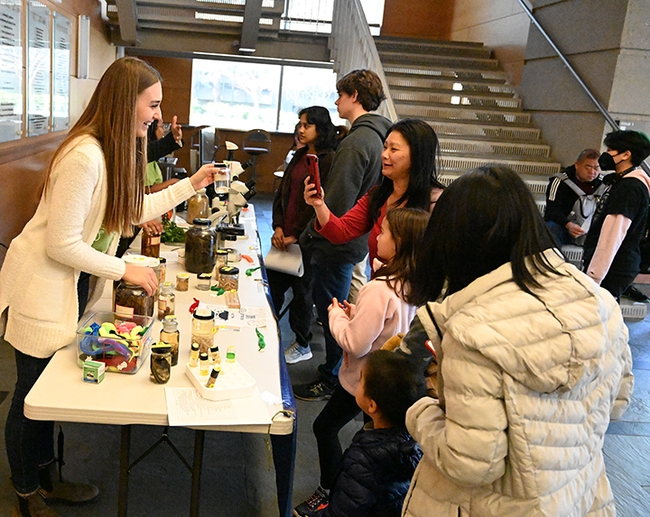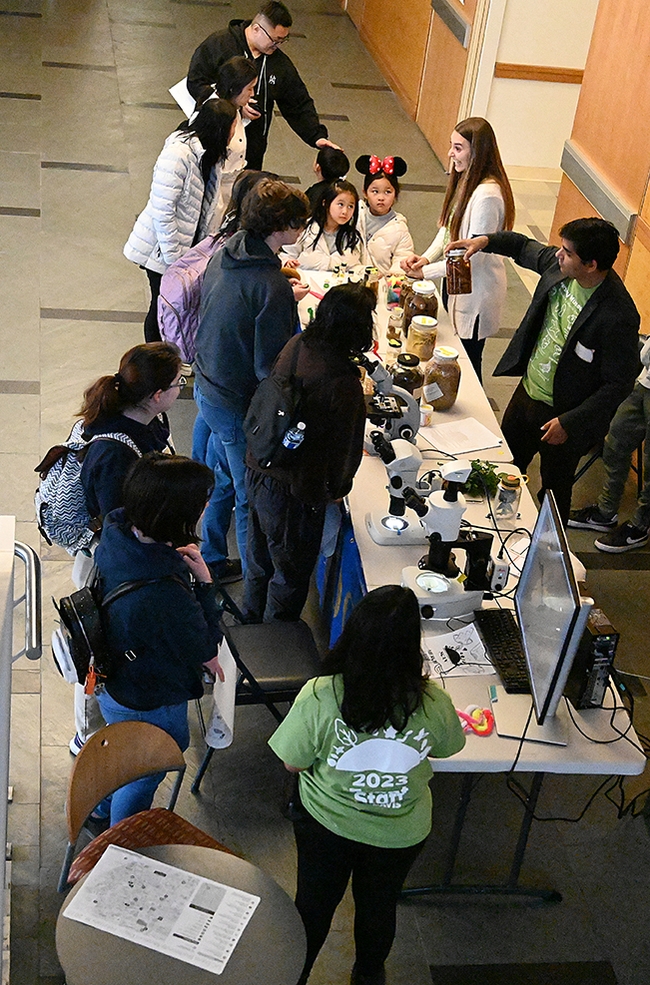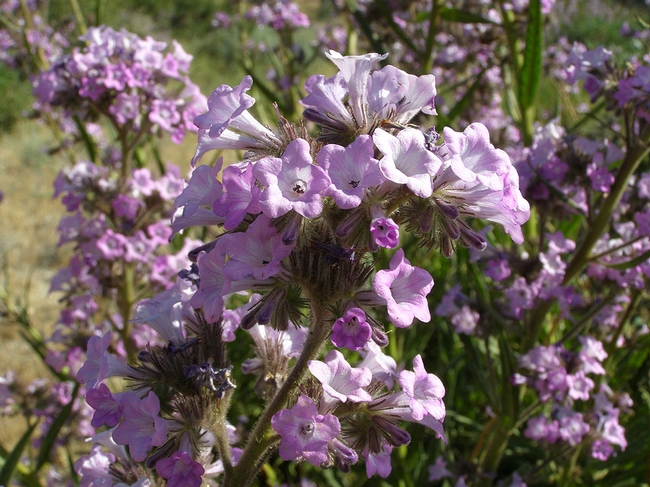
Posts Tagged: dog
Don't Miss the Nematode Collection at UC Davis Biodiversity Museum Day Feb. 10
Can you link nematodes, aka roundworms, with tomatoes, sugar beets, peaches, dogs,...

Nematologist Alison Blundell, a graduate student in the Shahid Siddique lab, shows nematode specimens at the 2023 UC Davis Biodiversity Museum Day. (Photo by Kathy Keatley Garvey)

Professor Shahid Siddique and his graduate student Alison Blundell talk to visitors at the UC Davis Biodiversity Museum Day. (Photo by Kathy Keatley Garvey)
Accidental dog poisoning on the rise

Veterinarians at the University of California, Davis, warn pet owners to be careful about using rat poisons and similar compounds.
In recent weeks, veterinarians at the UC Davis William R. Pritchard Veterinary Medical Teaching Hospital have seen a spike in accidental rodenticide poisonings. In the last two weeks of August alone, they diagnosed and treated six canine cases.
If not treated, a dog can die within a week of ingesting rodenticides.
"This is an all-too-common occurrence," said Karl Jandrey, assistant professor of clinical small animal emergency and intensive care at UC Davis. "People are trying to get rid of unwanted rodents, but are not realizing what these toxins do to the other animals who share that environment."
Keeping pets safe
Using proper pest control techniques can help keep family pets safe, said Roger Baldwin, UC Cooperative Extension advisor with the UC Integrated Pest Management Program. Baldwin, a wildlife pest management expert, is based at the UC Kearney Agricultural Research and Extension Center in Parlier.
Dogs can be affected by rodenticides two ways: by eating the poisoned bait or by eating an animal that was poisoned. Both can have serious consequences.
Home improvement stores like Lowes and Home Depot, and even grocery stores, carry a variety of products that may be used to control unwanted rats, mice, pocket gophers and ground squirrels. If the unwanted animals are inside the house, Baldwin recommends using traps rather than poison.
"If a poisoned animal dies behind a wall, you can't get it out and you have to live with the smell for weeks or months," Baldwin said.
Also, before baiting outdoor pests, Baldwin suggests making sure they are not also going inside buildings. If they are, find all potential access points and close them up.
If resorting to poison baits, buy a new product at the store and carefully read the label to understand when, where and how it can be used. Because of rapidly changing restrictions in recent years, old products in your garage or shed could be outdated.
Pocket gopher bait must be placed in the gopher's underground burrow. Even there, Baldwin said, certain dogs will dig up dead pocket gophers if they are close enough to the surface. Families with digging dogs will likely want to choose gopher traps. For ground squirrels, baits can be placed in bait stations or scattered very thinly on the ground through broadcast or spot treatments.
"When you use broadcast or spot treatments, there is relatively little danger to dogs or cats," Baldwin said. "But I would opt to use bait stations in my yard if I had pets running around, just to be on the safe side."
Some rodenticides contain ingredients that are anticoagulants, which slow the clotting of the blood. When dogs ingest these poisons, the active ingredients concentrate in the liver where they interfere with vitamin K storage and the production of blood clotting factors.
At UC Davis' veterinary teaching hospital, dealing with accidental poisoning by an anticoagulant rodenticide can require around-the-clock care with treatments in the intensive care unit to replenish blood clotting factors with fresh frozen plasma and replace vitamin K. If administered early enough, this treatment usually leads to a full recovery. Other rodenticides (e.g., bromethalin, cholecalciferol, strychnine and zinc phosphide) do not have antidotes, so treatment is more difficult.
One patient recently treated at UC Davis was Mocha, a one-year-old Belgian Malinois from Winters, Calif. Mocha had gotten into d-CON, a common rodenticide available at hardware stores.
Luckily, Mocha was brought to the veterinary teaching hospital in time. She responded well to treatment and was able to go home in two days.
"We are grateful for the care Mocha received at UC Davis," said Ken Shaw, Mocha's owner. "Like most dogs, Mocha is adventurous and likes to get into things she shouldn't. But after the treatment at UC Davis, she was home within a few days, happy and playful once again."
Look at (but don't touch!) this pretty but dangerous California native

A member of the forget-me-not family (Boraginaceae), the poodle-dog bush, Terricula parryi, is a subshrub (with flexible, slightly woody stems) commonly found in disturbed areas, but rarely seen under undisturbed conditions. It can grow almost 10 feet tall and has purple bell-shaped flowers. It grows in recently burned areas of several vegetation types including forest, oak woodland, chaparral, and even riparian areas. However, it is a relatively short-lived and will decrease in numbers two to five years after the fires as other native shrubs and trees recover.
Contact with this plant can cause severe skin irritation with swelling, itching and raised blisters similar to those caused by poison oak. It’s best to avoid it, but if you need to be in infested areas make sure to wear long pants and sleeves and to wash clothes and gear soon after contact. Rinse skin with cool water as soon as possible. It can take from 12 to 36 hours for the rash to appear, and symptoms can persist for up to two weeks. If symptoms do appear, cool compresses, calamine lotion or over-the-counter hydrocortisone creams may provide some relief. Fluid from the blisters will not spread the rash, but it’s best to refrain from scratching if possible, as open sores can be prone to other skin infections.
This plant is now extremely common in the Station Fire burn area in Angeles National Forest and in other Southern California wildlands that have had recent fires. It’s another good reason to respect all trail and road closures. For more information about the Station Fire closure areas and recovery, visit http://www.fs.usda.gov/angeles.

Poodle-dog bush, Kentucky Springs Canyon, Angeles National Fores. (Photo: BonTerra Consulting, Inc.)
Ticked Off
Now here's something that will tick you off. You're taking photos of bumble bees and honey...

Dog tick
